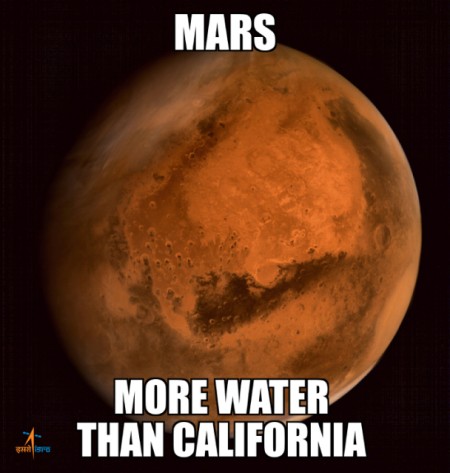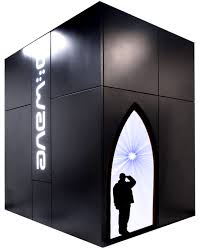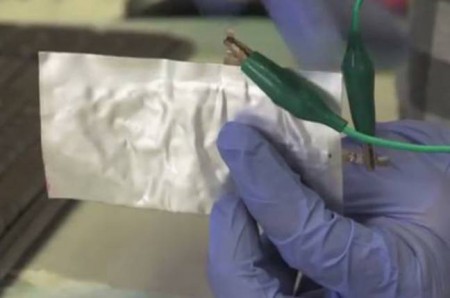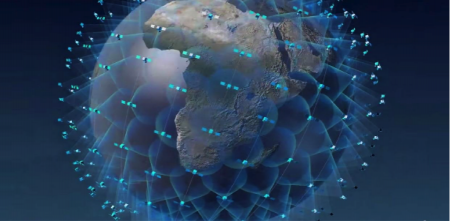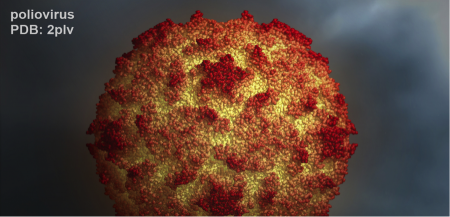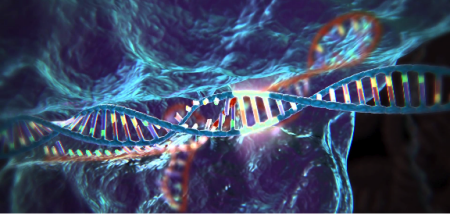December 31, 2015 – It is the last day of this year and I thought I would share with you the latest email blast from Peter Diamandis. Peter and his team of prognosticators and visionaries picked the following 10 from over 100 prospects. As in rocket launches our countdown goes from 10 to 1. Enjoy the read.
———-
10. NASA Confirms Evidence of Water of Mars
What happened: This year, NASA announced that their Mars Reconnaissance Orbiter (MRO) has provided the strongest evidence yet that liquid water flows intermittently on present-day Mars. Using an imaging spectrometer on the MRO, NASA identified hydrated minerals with patterns unique to flowing water.
Why it’s important: Based on what we know about living organisms, you need to have water to have life and as the image below suggests it appears that the planet has more than parched California in its fourth year of continuous drought. In my opinion, our next Mars mission, scheduled to land on Mars in 2020, will discover that life exists there now. This is just the beginning of a much larger initiative around the Red Planet. Once we detect life we will determine if it is identical to that of Earth (based on the same coding system, DNA) and whether there is a common origin.
9. Google’s Quantum Computer is 100 Million Times Faster Than a Normal Computer
What happened: After running a series of tests between their D-Wave quantum computer (which uses quantum bits, or “qubits”) and a normal single core computer (which uses normal bits), Google has concluded that the operation run on the quantum computer was 100 million times faster.
Why it’s important: As Moore’s Law continues to power exponential improvements in computing power and capacity, advances in quantum computing and other new computing mechanisms will help overcome current limitations and accelerate even more. These advances will be critical as we develop more advanced artificial intelligence systems, virtual simulations and optimization problems.
8. New Horizon’s Pluto Flyby
What happened: NASA’s New Horizons probe completed the first ever reconnaissance mission to Pluto. New Horizons launched on Jan. 19, 2006; it swung past Jupiter for a gravity boost and scientific studies in February 2007, and conducted a six-month-long reconnaissance flyby study of Pluto and its moons.
Why it’s important: This mission will help us understand the worlds at the edge of our solar system, and perhaps the origins of our own world. Moreover it represents a triumph for bold exploration – this American led project has now achieved a visit to every planet in our Solar System including even Pluto relegated to dwarf planet status. New Horizons will help us answer basic questions about the surface properties, geology, interior makeup and atmospheres of the Plutonian system and then in years to come will visit other members of the Kuiper Belt.
7. SEC Approves of Title III JOBS Act
What happened: In October, the United States Securities and Exchange Commission (SEC) voted on and passed rules to implement Title III of the JOBS Act – giving non-accredited investors the right to invest in companies via crowdfunding. Via the ruling, companies can now offer and sell securities through crowdfunding platforms like Crowdfunder.com and Angel.co.
Why it’s important: This ruling could unleash trillions of investment dollars now locked up in personal savings, IRAs, and investment accounts that sit around and basically only finance large companies in the public market. This capital will go on to fuel thousands of bold entrepreneurs who want to tackle the world’s most difficult problems or take the biggest moonshots. By aligning incentives, early investors will be able to participate in the upside of successful companies.
6. New Battery Technology Breakthroughs
What happened: This year, research teams, universities and startups made strides in advancing battery technology. Soon, we will begin to see batteries that charge in seconds, last months and even charge over the air. Laser-made supercapacitors are 50 times faster than current batteries, more durable and discharge even slower than current supercapacitors. Companies like Prieto are using copper foam to create 3D structures in batteries, resulting in longer life, faster charging, five times higher density, and are cheaper to make and smaller than current offerings. Tesla released their Powerwall to store solar energy in homes. The list goes on.
Why it’s important: Battery technology is critically important (and remains a key limiting factor) for the development of exponential technologies and computing devices. As our computers become more complex and distributed, so too do our demands for efficient and reliable sources of power. These developments will enable the convergence and distribution of key technologies like robotics, sensors, networks, AI, 3D printing and more.
5. One Step Closer to Global Internet Connectivity
What happened: Facebook (Internet.org – drones and satellite constellation), Google (Project Loon – helium balloons), and Qualcomm and Virgin (OneWeb – Satellite constellation) made strides this year to provide global connectivity to every human on Earth at speeds exceeding 1 Megabit per second. Google Loon actually deployed working balloons and OneWeb closed $500 million in capital to build its system.
Why It Is Important: We will grow from three to eight billion connected humans, adding five billion new consumers into the global economy over the next five years. These rising billions represent tens of trillions of new dollars flowing into the global economy. And they are not coming online like we did 20 years ago with a 9600 modem on AOL. They’re coming online with a 1 Mbps connection and access to the world’s information on Google, cloud 3D printing, Amazon Web Services, artificial intelligence with Watson, crowdfunding, crowd-sourcing, and more.
4. First New Antibiotic in 30 Years Discovered
What happened: A team from Northeastern University has discovered a new way to isolate antibiotic chemical compounds from microbes in soil, using an electronic chip to grow and control the microbes. The team discovered that one compound, Teixobactin, is highly effective against common bacterial infections.
Why it is important: The discovery of Teixobactin, could pave the way for a new generation of antibiotics because of how the team discovered and processed the drug. As we move closer to a world of abundance, drug resistance will become a surmountable challenge as we develop new ways to fight and resolve these problems. Teixobactin shows how we can adopt an alternative strategy and develop compounds to which bacteria are not resistant.
3. Engineered Polio Virus Treats Cancer
What happened: This year, doctors used a genetically re-engineered polio virus, PVS-RIPO, to treat glioblastoma — a brain tumor that carries a life expectancy of less than a year. Unlike other experimental treatments in the past using HIV, measles and smallpox, researchers from Duke found that polio actually seeks out and attaches itself to receptors that can be found on almost every solid tumor. Not only was this re-engineered polio virus successful in seeking out and poisoning cancerous cells, but it also steered clear of normal cells.
Why it is important: Advances in exponential technologies like synthetic biology and genomics are reinforcing the notion that previously unresolved diseases (cancer, heart disease, Alzheimer’s) are in fact resolvable. We are developing solutions to these problems at an accelerating rate, and as we usher in an era of personalized medicine, we will see a dramatic increase in the healthy human lifespan. At my company Human Longevity Inc, our mission is to make 100 the new 60.
2. Researchers in China Use CRISPR-Cas9 to Edit Genomes of Human Embryos
What happened: This year, a research team out of Guangzhou, China reported that they’d been able to edit the genomes of human embryos using CRISPR-Cas9 – a new gene splicing technique. Also this year, scientists from London’s Francis Crick Institute applied for approval to edit genes in human embryos. If approved, it will be the world’s first approval of such research by a national regulatory body.
Why It’s Important: CRISPR stands for Clustered Regularly Interspaced Short Palindromic Repeats. It is a strand of DNA that was found in 1987 to be part of a bacterial defense system. It turns out that we can actually use this same mechanism to target and splice specific strands of our DNA – in other words, the CRISPR/Cas system is a way to edit our genome. It is cheap, quick, easy to use, and more accurate than previous methods, and as a result, we will soon have the tools to eliminate diseases, create hardier plants, wipe out pathogens and much, much more.
1. SpaceX’s Successful Landing of the Falcon 9 First Stage
What happened: SpaceX successfully recovered the first stage of the Falcon 9 Orbital Launch Vehicle, bringing it back from near orbital speeds and altitude back to its point of departure at Kennedy Space Center.
Why it’s important: This is an accomplishment that the traditional launch industry had said was impossible. Because the first stage has 9 or 10 engines, this allows SpaceX to basically reuse over 80% of the vehicle’s parts, and significantly reduce the cost of future launches to orbit. It is a game-changer and a new era of spaceflight. Making the first stage of Falcon 9 reusable is a step towards a major demonetization of the space industry.
———-
So there you have it, Peter’s picks for 2015. Now it’s your turn to have a say on what were the most important technological and scientific breakthroughs you think happened this year. Please share your thoughts and I’ll publish them here.
To get the ball rolling I’ll share one with you that I think has been overlooked in this list. Although technically not a discovery or invention, the signing of a comprehensive climate change agreement in Paris at COP21 may prove to be the most positively disruptive change to come out of 2015.
To all my readers may 2016 be a happy and healthy year for you and your families and friends. And please keep coming back to read what’s posted on this site. There are tens of thousands of you visiting every month and I very much appreciate that you take the time to come here. And for those who are budding authors and want to make a writing contribution, feel free to contact me here with your ideas and words. I will do my best to share what you have to offer.


